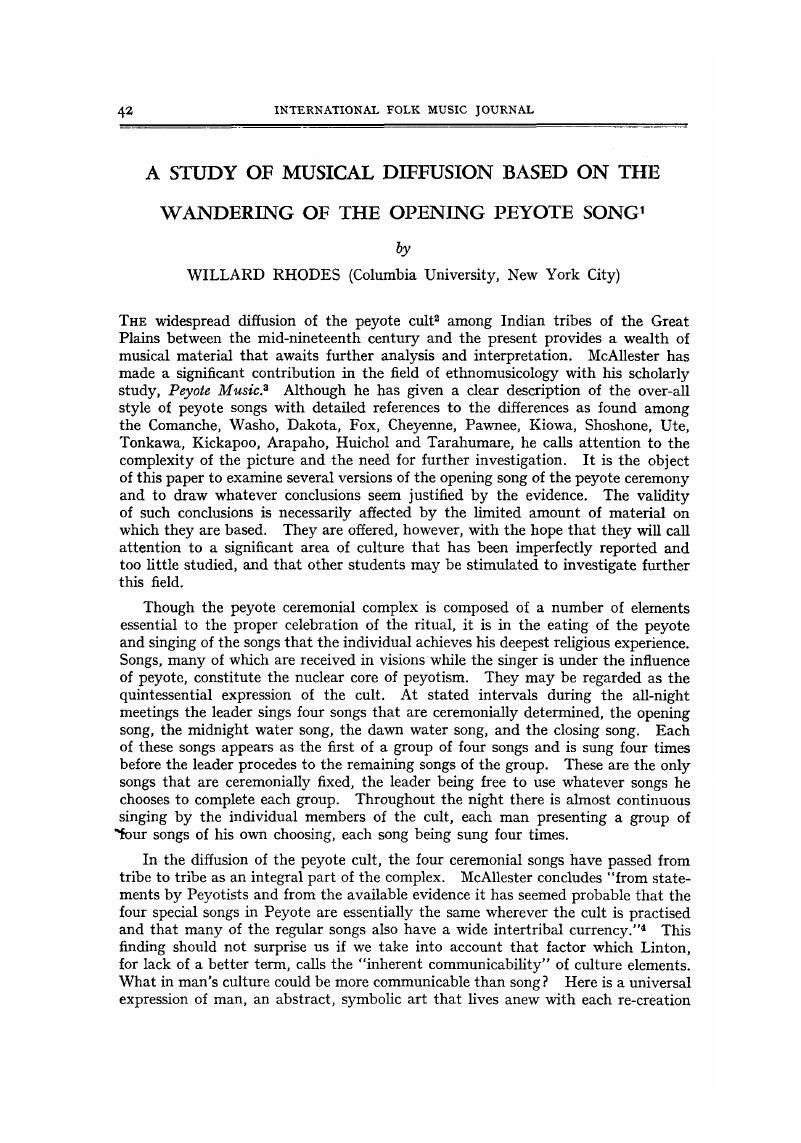No CrossRef data available.
Published online by Cambridge University Press: 07 March 2019

1. This paper is a revision of an earlier paper that was read at the Fifty-second Annual Meeting of the American Anthropological Association in Tucson, Arizona, December 1953.
2. The peyote cult, also known as the Native American Church, is a syncretic religion in which North American Indians have blended native religious beliefs and practices with the symbolism and teachings of Christianity. The peyote ceremony centres around the eating of the peyote, a small fleshy cactus found in Mexico. This is a source of spiritual power to the participant.
3. David P., McAllester, Peyote Music. Viking Fund Publication No. 13. New York 1949.Google Scholar
4. J. S., Slotkin, Menominee Peyotism, a Study of Variation in a Primary Group with a Homogeneous Culture. With Transcriptions and Analysis of Menominee Peyote Music by David P., McAllester. Transactions of the American Philosophical Society, New Series, Vol. 49, Part 4. Philadelphia, 1952. p. 681.Google Scholar
5. Paul, Radin, A Sketch of the Peyote Cult of the Winnebago: a Study in Borrowing. Journal of Religious Psychology, Vol. 7, No. 1, Jan. 1914. p. 7.Google Scholar
6. Music of the American Indian: Kiowa, recorded and edited by Willard Rhodes, AAFS L35. The Library of Congress, Washington, D.C.
7. Comanche, McAllester, op. cit., The Songs, No. 2 Google Scholar: Cheyenne, McAllester, op. cit., The Songs, No. 58, quoted from Frances Densmore, Cheyenne and Arapaho Music, Southwest Museum Papers, No. 10. May 1936. The Songs, No. 63, quoted from Natalie Curtis, The Indian's Book, New York, 1907, p. 188. Edward S., Curtis, The North American Indian, University Press, Cambridge, 1907-30. Vol. 19, pp. 205-6:Google Scholar Kiowa, Music of the American Indian, op. cit.: Dakota, Rhodes Collection of Indian Music, Library of Congress, Washington, D.C, 1942, Reel 6, No. 10. 1942 Reel 7, No. 9.: Southern Ute, Rhodes Collection of Indian Music, Library of Congress, Washington, D.C. 1942 Reel 8, No. 7: Menominee, J. S. Slotkin, op. cit. pp. 688-9: Winnebago, manuscript transcription of song sung by Sam Blowsnake furnished by David P. McAllester.
8. Willard, Rhodes, “Acculturation in North American Indian Music.” Tax, Acculturation in the Americas, Vol. 2, Proceedings of the 29th International Congress of Americanists. The University of Chicago Press, 1952, pp. 27–132.Google Scholar
9. There is the possibility that the song was originally a secular song and that it was incorporated into the ceremonialism of the cult by the peyotists.
10. This statement by Miss De Huff's pupil-informants regarding the Navajo origin of the song fails to stand in the light of more recent research and investigations that have been made by anthropologists. David Aberle, whose intensive study of the peyote cult among the Navajo may be accepted as authoritative, writes, “The Taos would appear to have had peyote at least since 1913, whereas the Ute complex cannot be dated any earlier than 1908 and probably 1914 to 1917 for the Southern Utes. Since the Navajos got it from the Southern Utes and so far as I can tell there were few Navajo peyotists prior to 1933, and perhaps 1936, I think that the idea of a song spreading to Taos from the Navajos is virtually out of the question. Navajo peyotists themselves regard the Taos as having earlier contact with peyote than they did.” (For detailed information consult David F., Aberle and Omer C., Stewart, Navaho and Ute Peyotism: Chronological and Distributional Study. University of Colorado Studies, Series in Anthropology, No. 6, 1957.Google Scholar
11. His Master's Voice B 2083. Transcribed from the record by George Herzog.
12. Rhodes Collection of Indian Music, Library of Congress, Washington, D.C. LWO 1483.
13. Carpets from the Looms of Mohawk, produced by Maxon, Inc., New York. 53510.